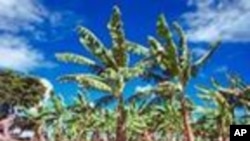It's peak hurricane season in the Caribbean Basin, a threat that is all too familiar to the millions of people living in the low-lying coastal region. Unknown to many, though, another potential hazard threatens the Caribbean, one that the United States is working hard to better understand.
Deep under the sea, cracks in the earth's crust pose an earthquake risk that could unleash massive waves, or tsunami, with devastating results, particularly for island nations such as Cuba, Haiti, the Dominican Republic and Jamaica. Little can be done to prevent such a catastrophe, but a broad monitoring system is being developed to provide an early warning and to help Caribbean nations be better prepared.
For over 40 years, an office of UNESCO, the United Nations science agency, has encouraged Caribbean states to invest in an integrated system of ocean observations to ensure sustainable coastal development and to reduce the risk of natural hazards. In 2004, the need to do more in the region was highlighted by the massive underwater earthquake in Indonesia that caused a tsunami devastating areas of Thailand, Burma and other nations around the Indian Ocean. More than 230,000 people died and hundreds of thousands more were injured or displaced.
While such disasters aren't common in the Caribbean, they aren't unique either. A tsunami struck the Dominican Republic in 1946, killing 1,790, and a similar disaster hit Puerto Rico in 1918.
The U.S. is contributing to the establishment of a regional warning system through the transfer of technology to analyze seismic, sea level, and other information relevant to the propagation of tsunami and other coastal hazards. As part of this effort, the U.S. will deliver a tide station to facilitate training of technicians on station operation and maintenance, interpretation of the resulting data, dissemination of warnings, and ensuring appropriate community response. The International Oceanographic Commission is helping the U.S. to leverage its many contributions with that of other donors such as the World Bank, which has pledged to deliver 11 stations to the region.
Deep under the sea, cracks in the earth's crust pose an earthquake risk that could unleash massive waves, or tsunami, with devastating results, particularly for island nations such as Cuba, Haiti, the Dominican Republic and Jamaica. Little can be done to prevent such a catastrophe, but a broad monitoring system is being developed to provide an early warning and to help Caribbean nations be better prepared.
For over 40 years, an office of UNESCO, the United Nations science agency, has encouraged Caribbean states to invest in an integrated system of ocean observations to ensure sustainable coastal development and to reduce the risk of natural hazards. In 2004, the need to do more in the region was highlighted by the massive underwater earthquake in Indonesia that caused a tsunami devastating areas of Thailand, Burma and other nations around the Indian Ocean. More than 230,000 people died and hundreds of thousands more were injured or displaced.
While such disasters aren't common in the Caribbean, they aren't unique either. A tsunami struck the Dominican Republic in 1946, killing 1,790, and a similar disaster hit Puerto Rico in 1918.
The U.S. is contributing to the establishment of a regional warning system through the transfer of technology to analyze seismic, sea level, and other information relevant to the propagation of tsunami and other coastal hazards. As part of this effort, the U.S. will deliver a tide station to facilitate training of technicians on station operation and maintenance, interpretation of the resulting data, dissemination of warnings, and ensuring appropriate community response. The International Oceanographic Commission is helping the U.S. to leverage its many contributions with that of other donors such as the World Bank, which has pledged to deliver 11 stations to the region.













